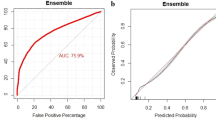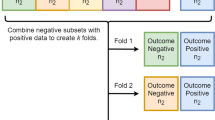Abstract
Purpose
The aim of this study is to develop a machine learning model to identify important clinical features related to rotator cuff tears (RCTs) using explainable artificial intelligence (XAI) for efficiently predicting outpatients with RCTs.
Methods
A retrospective review of a local clinical registry dataset was performed to include patients with shoulder pain and dysfunction who underwent questionnaires and physical examinations between 2019 and 2022. RCTs were diagnosed by shoulder arthroscopy. Six machine-learning algorithms (Stacking, Gradient Boosting Machine, Bagging, Random Forest, Extreme Gradient Boost (XGBoost), and Adaptive Boosting) were developed for the prediction. The performance of the models was assessed by the area under the receiver operating characteristic curve (AUC), Brier scores, and Decision curve. The interpretability of the predicted outcomes was evaluated using Shapley additive explanation (SHAP) values.
Results
A total of 1684 patients who completed questionnaires and clinical tests were included, and 417 patients with RCTs underwent shoulder arthroscopy. In six machining learning algorithms for predicting RCTs, the accuracy, AUC values, and Brier scores were in the range of 0.81–0.86, 0.75–0.92, and 0.15–0.19, respectively. The XGBoost model showed superior performance with accuracy, AUC, and Brier scores of 0.85(95% confidence interval, 0.82–0.87), 0.92 (95% confidence interval,0.90–0.94), and 0.15 (95% confidence interval,0.14–0.16), respectively. The Shapley plot showed the impact of the clinical features on predicting RCTs. The most important variables were Jobe test, Bear hug test, and age for prediction, with mean SHAP values of 1.458, 0.950, and 0.790, respectively.
Conclusion
The machine learning model successfully identified important clinical variables for predicting patients with RCTs. In addition, the best algorithm was also integrated into a digital application to provide predictions in outpatient settings. This tool may assist patients in reducing their pain experience and providing prompt treatments.
Level of Evidence
Level III.




Similar content being viewed by others
Data availability
The datasets generated and analysed during the current study are not publicly available due to limitations of ethical approval involving the patient data and anonymity but are available from the corresponding author on reasonable request.
Abbreviations
- RCTs:
-
Rotator cuff tears
- POSS:
-
Postoperative shoulder stiffness
- XAI:
-
Explainable artificial intelligence
- XGBoost:
-
Extreme gradient boost
- AUC:
-
Under the receiver operating curve
- SHAP:
-
Shapley additive explanation
- VAS:
-
Visual analogue scale
- ROM:
-
Range of motion
- ERLS:
-
External rotation lag sign
- IRLS:
-
Internal rotation lag sign
- ROC:
-
Receiver-operating characteristic curve
- DCA:
-
Decision curve analysis
References
Adams CR, Brady PC, Koo SS, Narbona P, Arrigoni P et al (2012) A systematic approach for diagnosing subscapularis tendon tears with preoperative magnetic resonance imaging scans. Arthroscopy 28:1592–1600
Audigé L, Aghlmandi S, Grobet C, Stojanov T, Müller AM et al (2021) Prediction of shoulder stiffness after arthroscopic rotator cuff repair. Am J Sports Med 49:3030–3039
Dikshit A, Pradhan B (2021) Interpretable and explainable AI (XAI) model for spatial drought prediction. Sci Total Environ 801:149797
Ercan N, Arican G, Taskent HC, Ozmeric A, Alemdaroglu KB (2021) Combined clinical test and magnetic resonance imaging have similar diagnostic values in the diagnosis of subscapularis tear. Knee Surg Sports Traumatol Arthrosc 29:2616–2623
Frangiamore S, Dornan GJ, Horan MP, Mannava S, Fritz EM et al (2020) Predictive modeling to determine functional outcomes after arthroscopic rotator cuff repair. Am J Sports Med 48:1559–1567
Furukawa R, Morihara T, Arai Y, Ito H, Kida Y et al (2014) Diagnostic accuracy of magnetic resonance imaging for subscapularis tendon tears using radial-slice magnetic resonance images. J shoulder Elbow Surg 23:e283–e290
Grazal CF, Anderson AB, Booth GJ, Geiger PG, Forsberg JA et al (2022) A machine-learning algorithm to predict the likelihood of prolonged opioid use following arthroscopic hip surgery. Arthroscopy 38:839-847.e2
Guo W, Jin J, Paynabar K, Miller BS, Carpenter JE (2015) A decision support system on surgical treatments for rotator cuff tears. IIE Trans Healthc Syst Eng 5:197–210
Heus P, Reitsma JB, Collins GS, Damen JAAG, Scholten RJPM et al (2020) Transparent reporting of multivariable prediction models in journal and conference abstracts: TRIPOD for abstracts. Ann Intern Med 173:42–47
Kappe T, Sgroi M, Reichel H, Daexle M (2018) Diagnostic performance of clinical tests for subscapularis tendon tears. Knee Surg Sports Traumatol Arthrosc 26:176–181
Kim I-B, Jung D-W (2018) A rotator cuff tear concomitant with shoulder stiffness is associated with a lower retear rate after 1-stage arthroscopic surgery. Am J Sports Med 46:1909–1918
Kjær BH, Magnusson SP, Henriksen M, Warming S, Boyle E et al (2021) Effects of 12 weeks of progressive early active exercise therapy after surgical rotator cuff repair: 12 weeks and 1 year results from the CUT-N-MOVE randomized controlled trial. Am J Sports Med 49:321–331
Lädermann A, Meynard T, Denard PJ, Ibrahim M, Saffarini M et al (2021) Reliable diagnosis of posterosuperior rotator cuff tears requires a combination of clinical tests. Knee Surg Sports Traumatol Arthrosc 29:2118–2133
Lee S, Park I, Lee HA, Shin S-J (2020) Factors related to symptomatic failed rotator cuff repair leading to revision surgeries after primary arthroscopic surgery. Arthroscopy 36:2080–2088
Lemaster NG, Hettrich CM, Jacobs CA, Heebner N, Westgate PM et al (2021) Which risk factors are associated with pain and patient-reported function in patients with a rotator cuff tear? Clin Orthop Relat Res 479:1982–1992
Lenza M, Buchbinder R, Takwoingi Y, Johnston RV, Hanchard NC et al (2013) Magnetic resonance imaging, magnetic resonance arthrography and ultrasonography for assessing rotator cuff tears in people with shoulder pain for whom surgery is being considered. Cochrane Database Syst Rev 9:CD009020
Lu Y, Forlenza E, Cohn MR, Lavoie-Gagne O, Wilbur RR et al (2021) Machine learning can reliably identify patients at risk of overnight hospital admission following anterior cruciate ligament reconstruction. Knee Surg Sports Traumatol Arthrosc 29:2958–2966
Lu Y, Forlenza E, Wilbur RR, Lavoie-Gagne O, Fu MC et al (2022) Machine-learning model successfully predicts patients at risk for prolonged postoperative opioid use following elective knee arthroscopy. Knee Surg Sports Traumatol Arthrosc 30:762–772
Maddali MV, Churpek M, Pham T, Rezoagli E, Zhuo H et al (2022) Validation and utility of ARDS subphenotypes identified by machine-learning models using clinical data: an observational, multicohort, retrospective analysis. Lancet Respir Med 10:367–377
Naimark M, Zhang AL, Leon I, Trivellas A, Feeley BT et al (2016) Clinical, radiographic, and surgical presentation of subscapularis tendon tears: a retrospective analysis of 139 patients. Arthroscopy 32:747–752
Pandey A, Kagiyama N, Yanamala N, Segar MW, Cho JS et al (2021) Deep-learning models for the echocardiographic assessment of diastolic dysfunction. JACC Cardiovasc Imaging 14:1887–1900
Plancher KD, Shanmugam J, Briggs K, Petterson SC (2021) Diagnosis and management of partial thickness rotator cuff tears: a comprehensive review. J Am Acad Orthop Surg 29:1031–1043
Requejo-Salinas N, Lewis J, Michener LA, La Touche R, Fernández-Matías R et al (2022) International physical therapists consensus on clinical descriptors for diagnosing rotator cuff related shoulder pain: a Delphi study. Brazilian J Phys Ther 26:100395
Salamh P, Lewis J (2020) It is time to put special tests for rotator cuff-related shoulder pain out to pasture. J Orthop Sports Phys Ther 50:222–225
Sengupta PP, Shrestha S, Kagiyama N, Hamirani Y, Kulkarni H et al (2021) A machine-learning framework to identify distinct phenotypes of aortic stenosis severity. JACC Cardiovasc Imaging 14:1707–1720
Stojanov T, Modler L, Müller AM, Aghlmandi S, Appenzeller-Herzog C et al (2022) Prognostic factors for the occurrence of post-operative shoulder stiffness after arthroscopic rotator cuff repair: a systematic review. BMC Musculoskelet Disord 23:99
van der Velden BHM, Kuijf HJ, Gilhuijs KGA, Viergever MA (2022) Explainable artificial intelligence (XAI) in deep learning-based medical image analysis. Med Image Anal 79:102470
Wolfe JC, Mikheeva LA, Hagras H, Zabet NR (2021) An explainable artificial intelligence approach for decoding the enhancer histone modifications code and identification of novel enhancers in Drosophila. Genome Biol 22:308
Zadro JR, Michaleff ZA, O’Keeffe M, Ferreira GE, Haas R et al (2021) How do people perceive different labels for rotator cuff disease? A content analysis of data collected in a randomised controlled experiment. BMJ Open 11:e052092
Zadro JR, O’Keeffe M, Ferreira GE, Haas R, Harris IA et al (2021) Diagnostic labels for rotator cuff disease can increase people’s perceived need for shoulder surgery: an online randomized controlled trial. J Orthop Sports Phys Ther 51:401–411
Acknowledgements
The authors acknowledge Dr. Phei Er Saw for proofreading this article and improving the languag.
Funding
This study was supported by the National Natural Science Foundation of China (no.81972067, 82002342) and Sun Yat-Sen University Clinical Research 5010 Program (no.2020004).
Author information
Authors and Affiliations
Contributions
RY conceived and design the study. CL participated in study design, conducted experiment and prepared primary manuscript. YA contributed to research thoughts and played a vital role in providing a critical review of the manuscript. HH and YL contributed to data collection and analysis. ZZ, KM participated in the experiment, data collection.
Corresponding author
Ethics declarations
Conflict of interest
The authors report no conflicts of interest in the authorship and publication of this article.
Ethical approval
This study was approved by the ethics committee of Sun Yat-sen Memorial Hospital (SYSEC-KY-KS-2021–184).
Informed consent
All patients were provided written consent.
Additional information
Publisher's Note
Springer Nature remains neutral with regard to jurisdictional claims in published maps and institutional affiliations.
Appendix
Appendix
See Appendix Table 3.
Rights and permissions
Springer Nature or its licensor (e.g. a society or other partner) holds exclusive rights to this article under a publishing agreement with the author(s) or other rightsholder(s); author self-archiving of the accepted manuscript version of this article is solely governed by the terms of such publishing agreement and applicable law.
About this article
Cite this article
Li, C., Alike, Y., Hou, J. et al. Machine learning model successfully identifies important clinical features for predicting outpatients with rotator cuff tears. Knee Surg Sports Traumatol Arthrosc 31, 2615–2623 (2023). https://doi.org/10.1007/s00167-022-07298-4
Received:
Accepted:
Published:
Issue Date:
DOI: https://doi.org/10.1007/s00167-022-07298-4




